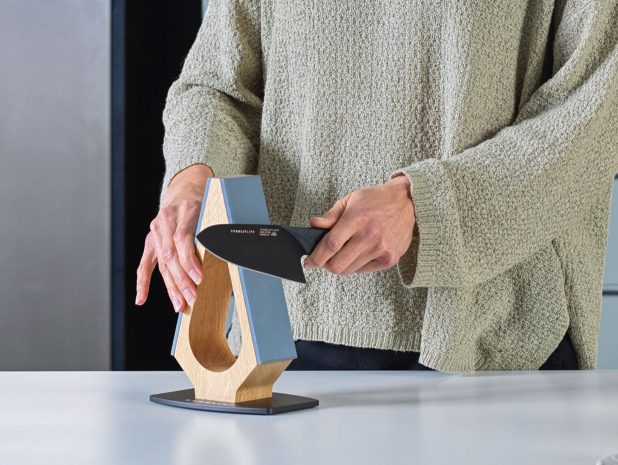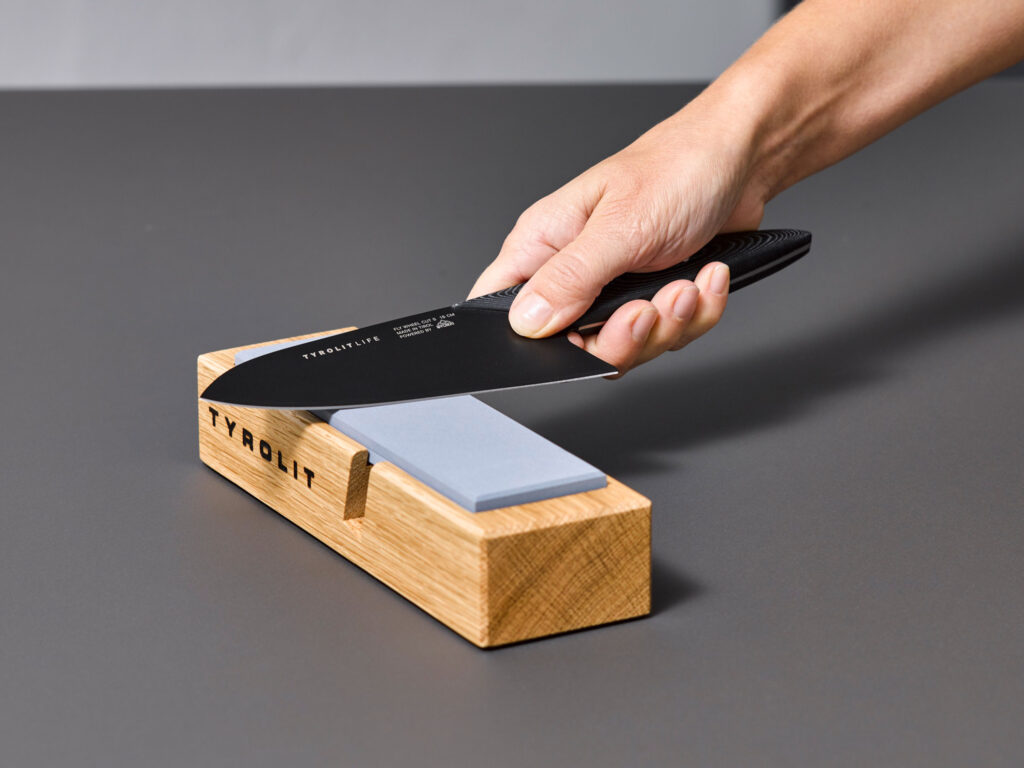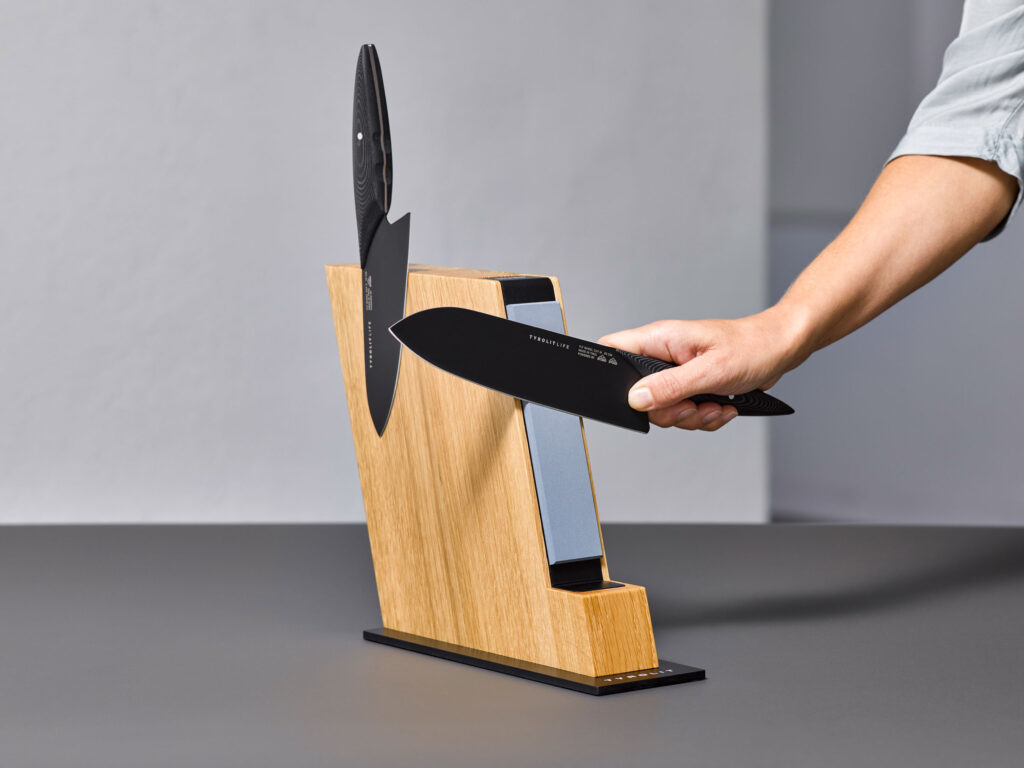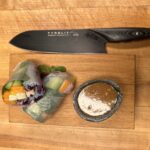Using a whetstone correctly – water vs. oil

Using a whetstone correctly not only causes uncertainty among many hobby chefs. Chefs in professional kitchens also often need to work quickly, and without proper practice, swiftly sharpening knives can quickly become a challenge. Additionally, the question of whether to use a water sharpening stone or an oil sharpening stone often arises.
In this article, we explore the differences between water whetstones and oil sharpening stones, illuminating the pros and cons of each option. We also consider which sharpening stone is suitable for whom and under what circumstances, as well as the correct application techniques. Additionally, you will discover how Tyrolit, the Tyrolean expert in abrasives, simplifies this process with premium products, enabling you to maintain your knives in optimal condition.
Sanding with liquids – why?
Why should one wet sharpen knives at all? Well, sharpening knives with liquids, whether it’s water or oil, is a proven process with several advantages.
This method serves to efficiently sharpen your knives by minimizing the buildup of metal swarf. The liquids facilitate the removal of metal particles and grinding residues. Essentially, the fluid prevents the accumulation of grinding debris on the rough surface of the sharpening stone, thereby maintaining its effectiveness.
Another advantage is that water or oil as a lubricant reduces friction between the blade and the grindstone. This not only enables precise cuts, but also protects the blade from excessive wear.
In the following section, the specific differences between water grindstones and oil grindstones are examined in more detail.
Water whetstone vs. oil whetstone – the differences
When sharpening knives, there are often water whetstones and oil whetstones to choose from. But what are the fundamental differences between the two?
Waterstones are made of abrasive materials bound together in a often porous matrix, which absorbs water that is released during the sharpening process. These stones are well suited for fine sharpening tasks on high-quality knives.
Oil sharpening stones, on the other hand, are made of harder material and require the use of oil as a lubricant. They are often more aggressive when sharpening and are good for tools and blunt blades – sculptors, for example, often rely on this type of sharpening stone.
Oil or water? A question of the stone
The choice between oil and water as a lubricant for your sharpening stone is not a matter of preference but depends on the type of sharpening stone. Be aware that you cannot simply switch between water and oil.
A water whetstone is specifically designed to absorb and release water during grinding. The porous structure of the stone supports the removal of metal particles. If you try to use a water grindstone with oil, it will lose its absorbency and will no longer work efficiently.
Synthetic sharpening stones also often rely on water. Ceramic stones such as those from Tyrolit do not have to be immersed in water, but simply moistened, which makes them ready for use faster.
On the other hand, oil whetstones are usually made of harder material that is not as porous as water whetstones. In this case, added water would not penetrate the material and impair the desired grinding properties, but would sometimes even decompose the stone.
Here are some typical materials from which water or oil stones are made – but since there may be deviations, you should definitely follow the instructions of the abrasive manufacturer.
Typical materials for water stones
- Corundum
- Belgian Coticule
- Ceramic
Typical materials for oil stones
- Arkansas Stone
- Alumina
- Silicon carbide
For whom each stone is suitable
Water sharpening stones are particularly suitable for finer work and high-quality knives. They are mainly used in kitchens and precision mechanical workshops. In addition, they are characterized by uncomplicated care and easy cleaning, so that these sharpening stones are also suitable for beginners.
On the other hand, oil sharpening stones are recommended for tools and blunt blades that require a more intensive sharpening action. This stone variant is often used in workshops and professional knife sharpening. They have a robust and durable surface, but water is usually more readily available and also easier to use.

Using a whetstone correctly – In 5 steps
To use your whetstone correctly, you can follow the following 5 steps. Apart from a few details, it does not matter whether you have a water stone or an oil stone in front of you – your technique and accuracy are much more important when you sharpen your knives yourself. You should also pay attention to when you sharpen your knives, because the duller the knife, the more complex the sharpening process.
1. Prepare your whetstone or sharpening stone
If necessary, start by thoroughly cleaning the whetstone to remove all residues and impurities. Then, depending on the type of grinding stone, apply the appropriate liquid: either water or oil.
When using water stones, you should either soak them beforehand or – in the case of Tyrolit Life ceramic whetstones – only briefly moisten them. Observe the manufacturer’s instructions for the soaking time; in principle, however, a water stone has absorbed sufficient water when no more bubbles rise.
2. Find a solid surface
After you have prepared your whetstone, it is important to find a stable and firm surface. Place the whetstone on a flat surface that is non-slip and provides sufficient stability. This ensures even results and prevents injuries.
3. Use different grits
Select the appropriate grit size for your sharpening stone based on the sharpening needs. Different grit sizes, as defined by FEPA, impact the sharpening process: Coarse grits quickly remove material, while finer grits are used for a refined finish.
Start with a coarser grit (e.g. 400) to repair any damage and then switch to finer grits (e.g. 800) to achieve the desired sharpness.
You can sharpen your knives very efficiently on combination stones with different grits. Tyrolit, for instance, offers whetstones with grits of 400 and 800
4. Sharpen evenly and at the correct sharpening angle
When sharpening your knives, it is crucial to apply even pressure and maintain the correct sharpening angle. For most European knives, the ideal angle is around 15 degrees, whereas Japanese knives are often sharpened to a finer edge. For beginners, finding and holding the proper sharpening angle can be challenging.
The Tyrolit knife sharpener, with its preset sharpening angle of 15 degrees, can provide invaluable assistance here. This practical tool ensures that you consistently sharpen your knives at the optimal angle, thereby achieving the best sharpening results.
5. Cleaning – not only the knives, but also the stone
After the sharpening process, it’s important to thoroughly clean not just the knives but also the sharpening stone itself. This is because deposits of metal particles and grinding residues can impair the sharpening performance.
For water stones, use running water to clean their surface. Oil stones, on the other hand, can be cleaned with a cloth. Then store your sharpening stone dry so that it is ready for the next sharpening process.

Applying whetstone made easy – with Tyrolit Life
Using whetstones or sharpening stones correctly can be a challenge even for experienced chefs. Tyrolit Life therefore makes knife sharpening much easier, both for beginners and professionals.
Tyrolit Life offers ceramic whetstones / sharpening stones with two different grits: 400 and 800. This combination offers optimal results for both rough and fine grinding.
A special highlight is the Tyrolit Life knife sharpener with a preset sharpening angle of 15 degrees. It combines the precision of the whetstone with the comfort of classic knife sharpeners. This greatly simplifies sharpening and ensures consistent, first-class results.
In addition, the Tyrolean abrasive expert also integrates his grinding stones into other kitchen tools, such as the Tyrolit knife block or the wooden cutting board. This accessory not only ensures that you can store and use your knives gently: it makes sharpening your high-quality kitchen knives quickly an almost incidental process, so that you can concentrate entirely on preparing delicious culinary delights.
FAQs
How to use a whetstone or sharpening stone?
How long does a sharpening stone need to soak?
How do I get my knives really sharp?
In which direction should you sharpen a knife?


